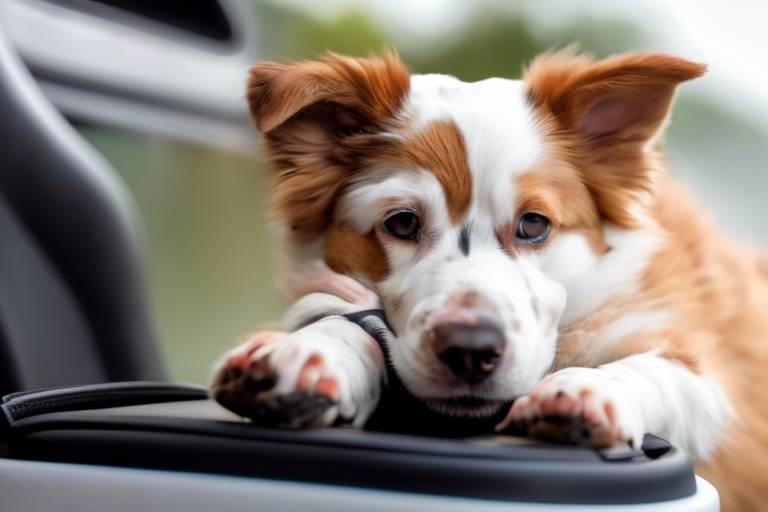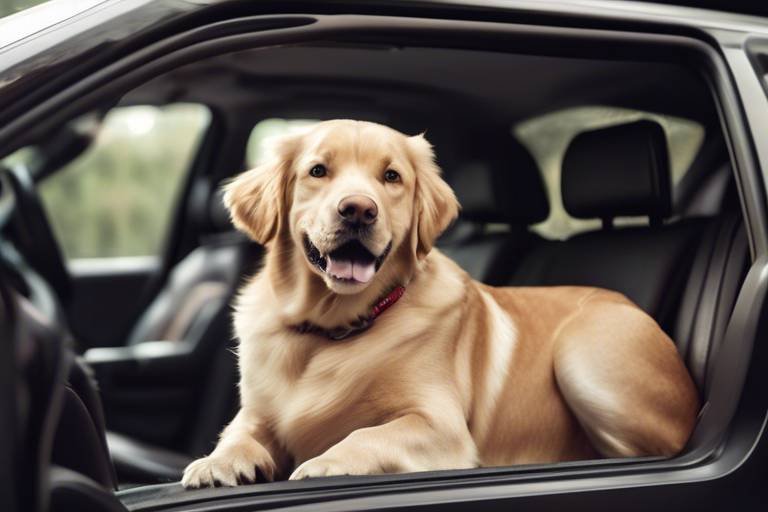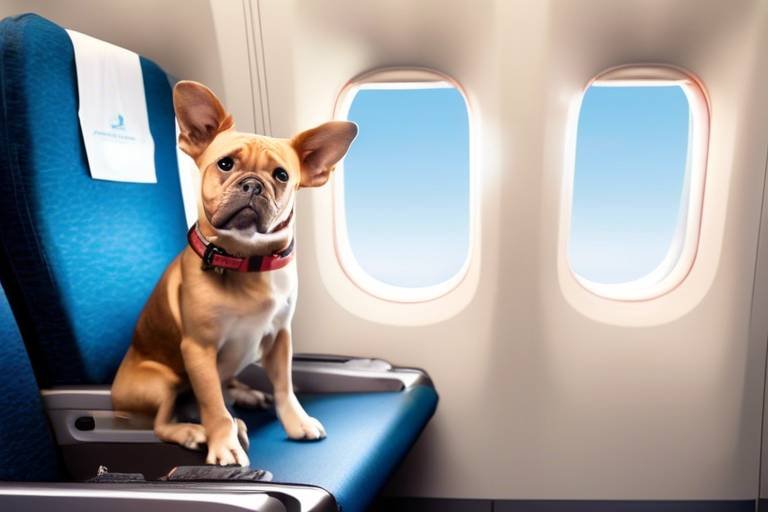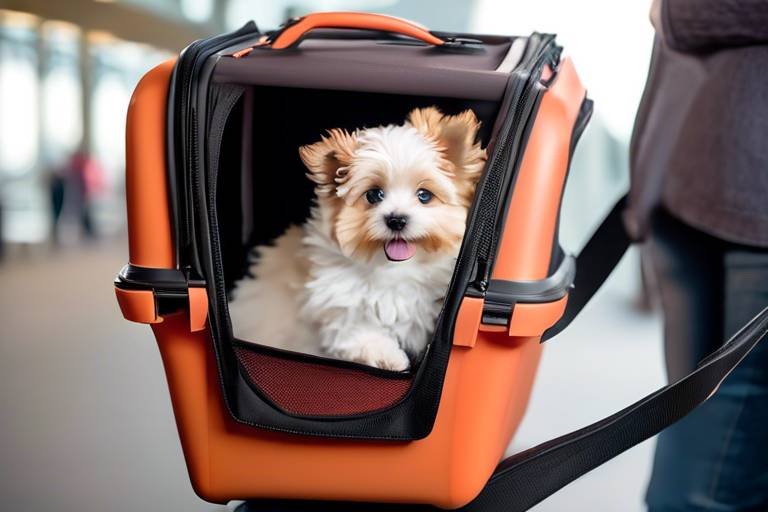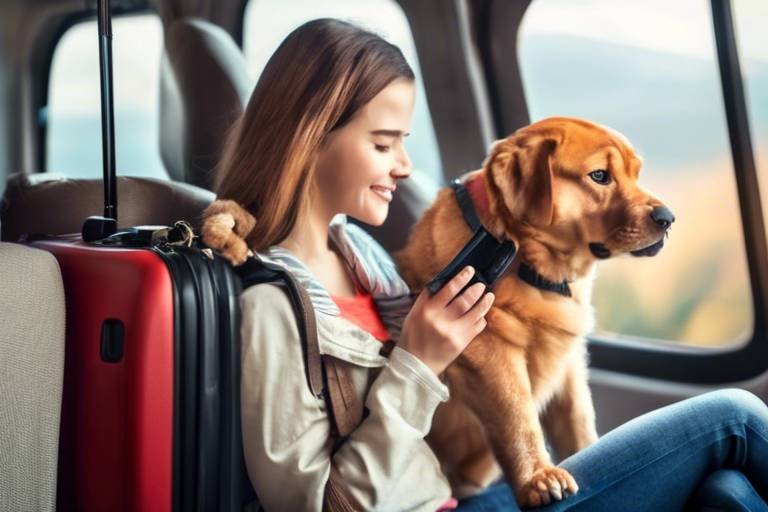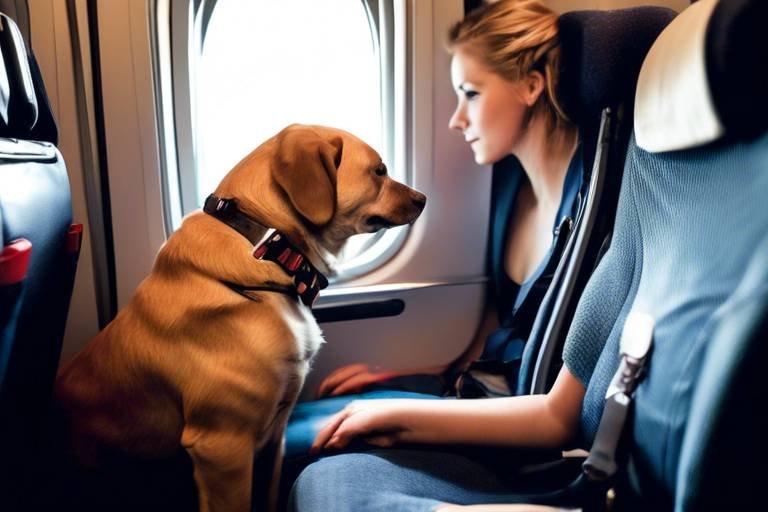How to Handle Pet Injuries While Traveling
Traveling with your furry friend can be one of the most rewarding experiences, but it also comes with its own set of challenges. Imagine cruising down the highway, your pet happily wagging their tail, when suddenly an accident happens. It’s a situation no pet owner wants to face, but being prepared can make all the difference. This article dives into essential tips and strategies for managing pet injuries during travel, ensuring your furry friends remain safe and comfortable on the go. After all, a little preparation can turn a potentially stressful situation into a manageable one.
Recognizing the types of injuries pets may sustain while traveling can help you prepare adequately and respond effectively when accidents occur. Just like humans, pets are susceptible to a variety of injuries, especially in unfamiliar environments. Some common injuries include:
- Scrapes and Cuts: These can occur from jumping out of the car or during outdoor adventures.
- Burns: Hot surfaces or chemicals can cause painful burns on your pet's paws or skin.
- Insect Bites: Exposure to insects can lead to allergic reactions or infections.
- Heatstroke: Pets can overheat quickly, especially in hot weather, leading to serious health issues.
By being aware of these potential injuries, you can take proactive steps to minimize risks and ensure your pet's safety while traveling.
A well-stocked first aid kit is crucial for addressing minor injuries or emergencies. Think of it as your pet's safety net—ready to catch them when they fall. Here are some essential items to include for your pet's safety:
Discover the must-have supplies that every pet first aid kit should contain, from bandages to antiseptics, ensuring you're ready for any situation. Here’s a quick overview:
| Item | Purpose |
|---|---|
| Adhesive Bandages | To cover small cuts and scrapes. |
| Antiseptic Wipes | For cleaning wounds to prevent infection. |
| Tweezers | To remove splinters or ticks. |
| Gauze Pads | For larger wounds requiring coverage. |
| Pet Thermometer | To check for fever in case of illness. |
Having these items on hand can make a world of difference in an emergency.
Understanding the necessary medications for your pet and their proper dosages can be vital in emergencies. Always consult your veterinarian before traveling to get recommendations tailored to your pet’s specific needs. Some common medications to consider include:
- Antihistamines: Useful for allergic reactions.
- Pain Relievers: To manage discomfort from injuries.
- Calming Aids: For anxious pets during travel.
Including emergency contact numbers for veterinarians and poison control can expedite care during a crisis. Learn how to organize this information effectively. Consider keeping a small card in your first aid kit with:
- Your veterinarian's contact information
- Nearby veterinary clinics along your travel route
- Animal poison control hotline
This ensures you have access to vital information when every second counts.
Not all injuries require immediate vet visits. However, knowing the signs that indicate when professional medical attention is necessary for your pet can save lives. Look out for:
- Excessive bleeding that doesn’t stop
- Signs of severe pain, such as whining or inability to move
- Vomiting or diarrhea that persists
When in doubt, it’s better to err on the side of caution and consult a vet.
Implementing safety measures during travel can help prevent injuries. Just like you buckle your seatbelt, your pet deserves the same level of safety. Here are some best practices for keeping your pet secure and comfortable on the road:
Selecting an appropriate carrier for your pet is crucial for their safety and comfort. Think of it as their travel home. Make sure it’s well-ventilated, spacious enough for them to stand and turn around, and secure enough to prevent escapes. Always acclimate your pet to the carrier before the trip to reduce anxiety.
Properly securing your pet in the vehicle can prevent injuries during travel. Consider using a pet seatbelt, a secured crate, or a pet barrier to keep them safe while on the move. This not only protects your pet but also keeps you focused on the road, reducing the risk of accidents.
Knowing how to respond to injuries when they occur can minimize suffering. If your pet does get injured, stay calm and assess the situation. Here’s how to manage pet injuries while traveling:
Learn essential first aid techniques for common pet injuries, including how to clean wounds and apply bandages effectively in a travel situation. For example, if your pet has a cut, gently clean the area with antiseptic wipes, apply a gauze pad, and secure it with adhesive bandages. Your quick actions can make a significant difference in their recovery.
Injuries can stress pets, making it essential to keep them calm. Discover techniques to soothe your pet during a crisis, ensuring their comfort and cooperation. Speak softly, pet them gently, and provide a familiar blanket or toy to help ease their anxiety.
Q: What should I do if my pet gets injured while traveling?
A: Assess the injury, administer basic first aid if possible, and seek veterinary help if necessary.
Q: How can I prevent my pet from getting injured during travel?
A: Use a secure carrier, buckle your pet in, and take regular breaks to stretch and relieve themselves.
Q: What items should I include in a pet first aid kit?
A: Essential items include bandages, antiseptic wipes, tweezers, gauze pads, and a thermometer.

Understanding Common Pet Injuries
When you're on the road with your furry companion, the last thing you want is for them to get hurt. However, accidents can happen, and it’s important to recognize the types of injuries that pets may sustain while traveling. Understanding these common injuries not only helps in preparing for emergencies but also ensures that you can respond effectively when accidents occur.
Some of the most frequent injuries that pets might face during travel include:
- Scrapes and Cuts: These can happen from jumping in and out of the vehicle or from encounters with sharp objects.
- Burns: Hot pavement or car interiors can lead to painful burns on your pet's paws or skin.
- Insect Bites: Pets can be susceptible to bites from mosquitoes, ticks, and fleas, which can lead to allergic reactions or transmit diseases.
- Fractures: A sudden stop or an accident can cause serious injuries such as fractures, especially in small pets.
- Heatstroke: Pets left in hot cars or exposed to the sun for extended periods can suffer from heatstroke, which is a serious medical emergency.
Each of these injuries comes with its own set of challenges. For instance, scrapes and cuts might seem minor, but they can easily become infected if not treated promptly. On the other hand, heatstroke can escalate quickly, requiring immediate attention. Recognizing the signs of these injuries is crucial. For example, if your pet is limping or excessively licking a certain area, it may indicate that they have sustained an injury that requires your attention.
Moreover, some injuries might not be immediately visible. For example, internal injuries from a car accident can take time to manifest. Thus, it’s essential to keep a close eye on your pet's behavior after any travel incident. Look for signs of distress, such as whining, hiding, or reluctance to move. These behaviors can be indicators that something is wrong, even if there are no visible wounds.
Understanding these common injuries is the first step in ensuring your pet's safety while traveling. By being aware and prepared, you can enjoy your adventures together without the constant worry of what could go wrong. Always remember, prevention is key, and knowing the signs can help you act quickly to protect your beloved companion.

Preparing a Pet First Aid Kit
Traveling with your furry friend can be an adventure filled with joy, but it also comes with its own set of challenges—especially when it comes to keeping them safe. One of the most important things you can do is to prepare a well-stocked pet first aid kit. This kit will be your best friend in case of minor injuries or emergencies, ensuring you’re ready to tackle any situation that might arise while on the road. But what should you include in this kit? Let’s dive into the essential items that will help keep your pet safe and sound.
A pet first aid kit should be tailored to your specific pet’s needs and the type of travel you’re undertaking. It’s not just about packing a few band-aids and calling it a day. You need to think about potential injuries your pet might face, from cuts and scrapes to allergic reactions or even more serious issues. By having the right supplies on hand, you can respond quickly and effectively, which can make all the difference in a stressful situation.
So, what exactly should be in your pet first aid kit? Here’s a quick rundown of must-have supplies:
- Adhesive Bandages: These are crucial for covering small cuts and abrasions.
- Antiseptic Wipes or Spray: Keeping wounds clean is vital to prevent infection.
- Gauze and Medical Tape: For larger injuries, you’ll need these to create a proper dressing.
- Scissors: Handy for cutting tape, gauze, or even fur if necessary.
- Thermometer: Monitoring your pet’s temperature can provide insights into their health.
- Medications: Include any prescribed medications your pet may need, along with a note on dosages.
Now, while it’s tempting to just throw these items into a bag, organization is key. Consider using a waterproof container to prevent damage from spills or moisture. You might also want to label sections of your kit for easy access. For instance, keep all wound care supplies in one area and medications in another. This way, you won’t waste precious time rummaging through everything when your pet needs immediate help.
Understanding the necessary medications for your pet and their proper dosages can be vital in emergencies. Common medications include antihistamines for allergic reactions or pain relievers specifically designed for pets. Always consult your veterinarian about what to include and ensure you have clear instructions on how much to administer based on your pet's weight and condition. Remember, what works for humans might not be safe for pets, so never assume!
In the chaos of a pet emergency, having quick access to important contact numbers can save valuable time. Include a list of your veterinarian’s phone number, the nearest emergency veterinary clinic, and poison control hotline numbers. You can even create a small card with this information and keep it in your first aid kit. This way, in case of an emergency, you won’t have to scramble to find your phone or search online. Just pull out the card and dial!
In conclusion, preparing a pet first aid kit is about being proactive and ensuring your furry friend’s safety while traveling. By having the right supplies and knowing how to use them, you can handle minor injuries effectively and reduce stress for both you and your pet. Remember, a little preparation goes a long way in keeping your adventures enjoyable and worry-free!
Essential Items for Your Kit
When you're on the road with your furry friend, having a well-stocked first aid kit can be a lifesaver. Just like you wouldn't head out on a road trip without snacks and a spare tire, you shouldn't travel without a pet first aid kit. Imagine this: you're cruising along, the sun is shining, and suddenly your pup jumps out of the car, landing awkwardly. What do you do? This is where your first aid kit comes into play. It’s not just a collection of random items; it’s a carefully curated selection of essentials that can help you manage minor injuries and even save your pet's life in emergencies.
So, what should you include in your kit? Here are some must-have supplies that every pet owner should pack:
- Adhesive Bandages: These are crucial for covering small cuts or abrasions, protecting them from dirt and infection.
- Antiseptic Wipes: To clean wounds before applying bandages, ensuring that no harmful bacteria linger.
- Gauze Pads and Wraps: Perfect for larger wounds or for wrapping up a sprained limb.
- Scissors: Handy for cutting tape, gauze, or even fur if needed.
- Disposable Gloves: To keep things hygienic while treating your pet.
- Thermometer: Knowing your pet's temperature can help you gauge their health during a crisis.
- Pet-Safe Pain Relievers: Always check with your vet for recommendations on what’s safe for your pet.
- Emergency Blanket: A lightweight blanket can help keep your pet warm if they’re in shock.
In addition to these items, consider including a copy of your pet's medical records and any specific medications they may need. This way, if you find yourself in a situation where you need to visit a vet, you'll have all the necessary information at your fingertips. It’s like having a cheat sheet for your pet’s health!
Don't forget to tailor your kit to your pet's specific needs. For example, if your dog has allergies, include antihistamines that your vet recommends. If you have a cat, consider adding a cat-specific item like a calming spray. The key is to be prepared for any scenario, because when it comes to our pets, we never want to be caught off guard.
Lastly, remember to regularly check your first aid kit. Just like we check our own supplies at home, make sure to replace any expired medications or used items. A well-maintained first aid kit is your best ally for safe travels with your beloved pet!
Q: How often should I check my pet first aid kit?
A: It's a good idea to check your kit every few months to ensure that all items are in good condition and that medications haven't expired.
Q: Can I use human medications on my pet?
A: Some human medications can be harmful to pets. Always consult your veterinarian before giving any medication to your pet.
Q: What should I do if my pet gets injured while traveling?
A: Assess the injury, apply basic first aid if necessary, and seek veterinary care if the injury seems serious or if you're unsure.
Medication and Dosages
When it comes to traveling with your pets, being prepared means having a solid understanding of the necessary medications and their proper dosages. Just like humans, pets can experience a range of health issues, and knowing how to address them can make all the difference in an emergency. Imagine you're on a road trip, and your furry friend suddenly shows signs of distress. Wouldn't it be a relief to know exactly what to do?
First off, it's essential to consult with your veterinarian before embarking on any journey. They can provide you with a tailored list of medications that are suitable for your pet, based on their specific health needs. This proactive approach not only ensures that you have the right supplies but also gives you peace of mind. Some common medications you might consider include:
- Antihistamines: Useful for allergic reactions, especially if your pet is prone to environmental allergies.
- Pain Relief: Non-steroidal anti-inflammatory drugs (NSAIDs) can help alleviate discomfort if your pet injures themselves.
- Antibiotics: These are critical for treating infections, especially if your pet has a wound.
- Calming Agents: If your pet gets anxious during travel, a mild sedative can help keep them calm.
Now, let’s talk about dosages. Administering the wrong dose can lead to serious complications, so it’s vital to have clear guidelines. Most medications will come with dosage instructions, but here’s a general idea of how dosages are typically calculated:
| Medication | Weight Range (lbs) | Dosage (mg) |
|---|---|---|
| Antihistamines | 10-20 | 5-10 |
| Pain Relief | 20-50 | 10-25 |
| Antibiotics | 10-30 | 5-15 |
| Calming Agents | 5-20 | 1-5 |
Always remember, these are just general guidelines; your veterinarian's advice should be your primary resource. Additionally, keeping a detailed record of your pet's medication schedule, including dosages and times, can help you stay organized and ensure you never miss a dose.
In case of an emergency, having this information readily accessible can save precious time. Consider creating a small medication log that you can keep in your pet's first aid kit. This log should include the medication name, dosage, frequency, and any special instructions. It’s like having a lifeline in your pocket!
In summary, understanding your pet's medication needs and dosages is not just about being prepared; it's about ensuring their health and safety while you explore the world together. With the right knowledge and tools, you can travel confidently, knowing that you’re ready to handle any situation that comes your way.
Emergency Contact Information
When it comes to ensuring your pet's safety while traveling, having the right readily available can make all the difference. Imagine you’re on a scenic road trip, and your furry friend suddenly becomes unwell or sustains an injury. In such moments, every second counts, and having quick access to vital information can expedite care and potentially save your pet's life.
To prepare for any emergencies, it's essential to compile a list of important contacts before you hit the road. This list should include:
- Your veterinarian's contact number: It's crucial to have your regular vet's phone number on hand, especially if you're traveling locally.
- Emergency veterinary clinics: Research and note down the nearest emergency veterinary clinics along your travel route.
- Animal poison control hotline: Accidents can happen, and knowing whom to call if your pet ingests something harmful is vital.
Consider organizing this information in a way that is easy to access. A simple table can be an effective tool for this purpose:
| Contact Type | Name | Phone Number | Address |
|---|---|---|---|
| Your Veterinarian | Dr. Smith's Animal Clinic | (555) 123-4567 | 123 Pet Lane, YourTown, ST |
| Emergency Vet | 24/7 Pet Emergency Center | (555) 987-6543 | 456 Animal Ave, YourTown, ST |
| Poison Control | Animal Poison Control | (888) 426-4435 | N/A |
Store this information in a place that is easy to access, such as your phone or a printed copy in your travel bag. Additionally, consider sharing this information with a travel companion, just in case you are unable to reach it in an emergency.
By being proactive and having a solid plan in place, you can travel with peace of mind, knowing that you're prepared for any situation that may arise. Remember, the goal is to keep your pet safe and comfortable, and quick access to these emergency contacts can be a lifesaver.
When to Seek Veterinary Help
When traveling with your furry companion, it's crucial to be vigilant about their well-being. Not every scrape or bruise necessitates a trip to the vet, but some injuries can be serious and require immediate attention. Understanding the signs that indicate when to seek veterinary help can make a significant difference in your pet's health and comfort.
For instance, if your pet suffers from a deep wound that won't stop bleeding, or if you notice signs of severe pain, such as whining or refusing to move, it's time to consult a veterinarian. Additionally, if your pet exhibits any of the following symptoms, you should not hesitate to seek professional medical help:
- Persistent Vomiting: If your pet is vomiting repeatedly, it could indicate a serious issue.
- Difficulty Breathing: Any signs of labored breathing or excessive panting should be taken seriously.
- Unconsciousness or Disorientation: If your pet seems confused or unresponsive, immediate veterinary care is essential.
- Severe Diarrhea: Especially if it contains blood, this can lead to dehydration.
- Signs of Shock: Pale gums, rapid heartbeat, and weakness are all signs that your pet may be in shock and needs urgent care.
Moreover, it’s important to remember that some injuries may not show immediate symptoms. For example, if your pet has been in an accident but seems fine, keep an eye on them for the next 24 hours. Sometimes, internal injuries can manifest later, so being attentive during this time is critical.
In addition to recognizing physical symptoms, you should also pay attention to your pet's behavior. Changes in their usual habits, such as decreased appetite, lethargy, or unusual aggression, can signal that something is wrong. Your pet might not be able to tell you they're in pain, but they can communicate discomfort through their actions.
If you're ever in doubt, it's always better to err on the side of caution. A quick call to your veterinarian can provide peace of mind and guidance on whether a visit is necessary. Remember, timely intervention can prevent a minor issue from escalating into a major health crisis.
Lastly, keeping a list of emergency contact numbers, including your veterinarian and local animal hospitals, can facilitate quicker responses in case of an emergency. Having this information readily available can save precious time when every moment counts.
Q: How can I tell if my pet is in pain?
A: Look for signs such as whining, limping, reduced appetite, or changes in behavior. If they seem unusually quiet or aggressive, it may indicate discomfort.
Q: What should I do if my pet has a bleeding wound?
A: Apply gentle pressure with a clean cloth to stop the bleeding. If it doesn't stop after a few minutes, seek veterinary help immediately.
Q: Can I give my pet human medication for pain?
A: Never give your pet human medications without consulting a veterinarian first. Many human drugs can be toxic to pets.
Q: How do I find a vet in an unfamiliar area?
A: Use online tools or apps to locate nearby veterinary clinics. You can also ask local pet owners for recommendations.

Traveling Safely with Your Pet
Traveling with your pet can be an exhilarating experience, but it also comes with its own set of challenges. Ensuring your furry friend is safe and comfortable during the journey is paramount. Imagine embarking on a road trip, with your beloved dog happily wagging its tail in the back seat. However, without proper precautions, that blissful scenario can quickly turn into a stressful situation. So, how can you make sure your pet travels safely? Let’s dive into some essential tips!
First and foremost, preparation is key. Before you hit the road, it’s crucial to familiarize yourself with the regulations regarding pet travel in your destination. Some places have specific rules about pet carriers, leashes, and even vaccination records. Being informed can save you from unexpected hassles and ensure a smoother journey. Additionally, consider your pet’s comfort during the trip. Just like us, pets can get restless and anxious during long drives. To combat this, plan for regular breaks where your pet can stretch, relieve itself, and hydrate.
One of the most significant aspects of traveling safely with your pet is choosing the right carrier. A carrier isn’t just a box; it’s a sanctuary for your pet during travel. It should be well-ventilated, spacious enough for your pet to stand, turn around, and lie down comfortably. If you have a larger dog, a sturdy, well-designed travel crate is essential. For smaller pets, a soft-sided carrier might be a great option. Remember, the carrier should be familiar to your pet before the trip. Allow them to explore it at home, so they associate it with positive experiences.
When it comes to securing your pet in the vehicle, there are several methods to consider. Using a pet seatbelt or a harness can prevent your pet from roaming around the car, which is not only dangerous for them but also distracting for you as the driver. Alternatively, if your pet is in a crate, ensure it’s secured with a seatbelt or placed in the trunk if your vehicle allows it. This way, your pet remains safe and snug, reducing the risk of injury in case of sudden stops or accidents.
Moreover, keeping your pet calm during the journey is essential. Some pets may feel anxious in a moving vehicle, and this can lead to distress or even injury. To help soothe your pet, consider bringing along their favorite blanket or toy. Familiar scents can have a calming effect, making them feel secure in an unfamiliar environment. Additionally, playing soft music can create a peaceful atmosphere, helping to ease any travel anxiety.
Lastly, never underestimate the importance of keeping your pet hydrated and well-fed during the trip. Just like you wouldn’t want to travel without snacks and drinks, your pet deserves the same consideration. Bring along plenty of water and a portable bowl for quick hydration breaks. If your journey is long, pack some of their regular food to avoid any digestive issues. Remember, a well-fed and hydrated pet is a happy pet!
In summary, traveling safely with your pet requires a blend of preparation, the right equipment, and a focus on their comfort. By following these tips, you can ensure that your travels are enjoyable for both you and your furry companion. After all, the road is meant to be explored together, creating memories that will last a lifetime!
- What should I do if my pet gets car sick? - If your pet is prone to motion sickness, consult your veterinarian for advice. They may recommend medications or tips to help manage the situation.
- Can I take my pet out of the carrier during travel? - It’s best to keep your pet secured in their carrier or harness while the vehicle is in motion to ensure their safety.
- How often should I take breaks during a long trip? - Aim to take a break every 2-3 hours to allow your pet to stretch, relieve themselves, and hydrate.
Choosing the Right Carrier
When it comes to traveling with your furry companion, one of the most critical decisions you’ll make is choosing the right carrier. Think of the carrier as your pet's personal travel sanctuary—it's where they will spend a significant amount of time, and it should be comfortable, safe, and secure. A well-chosen carrier not only ensures your pet's safety but also helps to alleviate their stress during travel. So, what should you consider when making this important choice?
First and foremost, size matters! Your pet should be able to stand up, turn around, and lie down comfortably in their carrier. If the carrier is too small, your pet may feel cramped and anxious. On the other hand, a carrier that is too large can lead to instability, making it easier for your pet to get tossed around during travel. To help you visualize the ideal size, here’s a quick reference table:
| Pet Size | Recommended Carrier Size |
|---|---|
| Small (up to 10 lbs) | 18" x 12" x 10" |
| Medium (10-25 lbs) | 24" x 16" x 14" |
| Large (25-50 lbs) | 30" x 20" x 19" |
Next, consider the material of the carrier. There are various options, including hard-sided plastic carriers, soft-sided fabric carriers, and even collapsible carriers. Hard-sided carriers offer more protection and durability, making them ideal for larger pets or longer trips. Soft-sided carriers, on the other hand, are lighter and more portable, which can be a significant advantage for quick trips or air travel. Think about your travel style and your pet's temperament when making this decision.
Another crucial factor is ventilation. A well-ventilated carrier ensures that your pet has enough fresh air during the journey. Look for carriers with mesh panels or vents that allow for airflow while keeping your pet secure. Additionally, consider the ease of access. A carrier with multiple openings can make it easier to get your pet in and out, especially if they are a bit anxious about traveling.
Lastly, don’t forget about safety features. Ensure that the carrier has secure latches and is escape-proof. You wouldn’t want your adventurous pet to make a break for it while you’re on the road! Also, consider adding a familiar blanket or toy inside the carrier to help your pet feel more at home during the trip. This little touch can make a world of difference in easing their anxiety.
In summary, choosing the right carrier is about finding the perfect balance between comfort, safety, and practicality. By paying attention to size, material, ventilation, access, and safety features, you can ensure that your pet has a pleasant travel experience. After all, a happy pet means a happy journey!
- What size carrier should I choose for my pet? Always select a carrier that allows your pet to stand up, turn around, and lie down comfortably. Refer to the size chart above for guidance.
- Are soft-sided carriers safe for air travel? Yes, many airlines accept soft-sided carriers, but always check with your airline for specific requirements.
- How can I help my pet feel more comfortable in their carrier? Include a familiar blanket or toy, and allow them to explore the carrier at home before the trip.
Securing Your Pet in the Vehicle
When it comes to traveling with your furry friend, ensuring their safety in the vehicle is absolutely crucial. Think of your pet as a precious cargo that needs to be protected just like you would secure a fragile item. Unsecured pets can become dangerous projectiles in the event of sudden stops or accidents, leading to serious injuries for both your pet and passengers. So, how do you go about securing your pet effectively? Let's dive into some practical strategies that will keep your pet safe and sound during your travels.
First and foremost, choosing the right restraint system is key. There are various options available, including pet seat belts, harnesses, and crates. Each of these has its own benefits, and the choice largely depends on your pet's size, temperament, and the type of vehicle you are using. For instance, a sturdy crate can provide a safe haven for smaller dogs, while larger breeds might benefit from a well-fitted harness that attaches to the seatbelt. The goal is to keep your pet secure without restricting their movement too much, allowing them to sit or lie down comfortably.
Another important consideration is the placement of your pet in the vehicle. Ideally, pets should be secured in the back seat rather than the front seat. This not only minimizes the risk of injury from airbags but also helps reduce distractions for the driver. If you have multiple pets, it’s best to keep them separated to prevent any unnecessary squabbles during the ride. You can use pet barriers or travel crates to create a safe space for each pet.
It's also wise to make sure your pet is accustomed to the vehicle before embarking on a long journey. Take them on short trips to help them adjust, and reward them with treats or praise to create a positive association with the car. This can help alleviate any anxiety they might feel during longer travels. Remember, a calm pet is a safe pet!
And don't forget to take regular breaks during your journey. Just like us, pets need to stretch their legs and relieve themselves. Plan for frequent stops at pet-friendly locations where your furry friend can get some exercise and fresh air. This not only helps keep them comfortable but also reduces restlessness that can lead to accidents in the vehicle.
To summarize, securing your pet in the vehicle involves a combination of the right restraint system, proper placement, acclimatization, and regular breaks. By taking these precautions, you can ensure that your travels are safe and enjoyable for both you and your beloved pet. Remember, a little preparation goes a long way in making your road trips memorable for all the right reasons!
- What type of restraint is best for my pet? It depends on the size and temperament of your pet. For smaller dogs, a crate or carrier is often best, while larger dogs may benefit from a harness that attaches to the seatbelt.
- Can I let my pet roam freely in the car? No, it's not safe. An unsecured pet can be a distraction and can get injured in case of sudden stops or accidents.
- How often should I take breaks during a long trip? It's recommended to take a break every 2-3 hours to let your pet stretch, hydrate, and relieve themselves.
- Is it safe to travel with my pet in the front seat? It's best to keep pets in the back seat to avoid the risk of injury from airbags and to minimize distractions for the driver.

Handling Injuries on the Road
When you're on the road with your furry companion, the last thing you want is for them to get injured. However, accidents can happen, and it's crucial to be prepared. Knowing how to respond to pet injuries while traveling can make a world of difference in minimizing their suffering and ensuring a swift recovery. Just like a well-oiled machine, being ready for any bumps in the road can keep your journey smooth and stress-free.
First, it's essential to assess the situation calmly. If your pet is injured, they might be scared or in pain, and your reaction can greatly influence their behavior. Remember, pets can sense your emotions, so try to stay composed. Take a deep breath, and gently approach your pet. Speak softly to reassure them. This is akin to being a lighthouse in a storm; your calm presence can guide them through the chaos.
Next, you should evaluate the injury. Is it a minor scrape or a more serious wound? For minor injuries, you can often handle them with basic first aid techniques, which we'll dive into shortly. However, if the injury appears severe—like excessive bleeding, difficulty breathing, or if your pet is unresponsive—it's crucial to seek veterinary help immediately. Time is of the essence in such situations, and a quick decision can save your pet's life.
For those minor injuries, having a basic understanding of first aid can empower you to take action. Here are some fundamental techniques you might find helpful:
- Cleaning Wounds: If your pet has a cut or scrape, gently clean the area with lukewarm water and a mild antiseptic. Avoid using alcohol or hydrogen peroxide, as these can irritate the wound.
- Applying Bandages: After cleaning, use a sterile bandage to cover the wound. Make sure it's snug but not too tight, as you don't want to cut off circulation.
- Managing Bleeding: If your pet is bleeding, apply gentle pressure with a clean cloth or bandage until the bleeding stops. If it doesn't stop after a few minutes, seek veterinary assistance.
In addition to treating injuries, it's crucial to keep your pet calm. An injured pet can become anxious, making the situation more complicated. Think of it as trying to calm a child who has fallen; your soothing words and gentle touch can work wonders. You can try the following methods:
- Soft Voices: Use a calm and soothing tone to talk to your pet. This helps them feel safe and reduces anxiety.
- Comforting Touch: Gently pet your injured animal. Your touch can be incredibly reassuring and help them relax.
- Distraction Techniques: If your pet is alert enough, try to distract them with their favorite toy or treat to take their mind off the pain.
Lastly, always have a plan for emergencies. This includes knowing the location of the nearest veterinary clinic along your travel route. Having this information handy can save precious time in a crisis. You might want to create a small travel folder that includes:
| Information | Details |
|---|---|
| Veterinarian Contact | Name, Phone Number, Address |
| Emergency Animal Hospital | Name, Phone Number, Address |
| Poison Control Hotline | Phone Number |
By being prepared and knowing how to handle injuries on the road, you can make your travels with your pet much more enjoyable and safe. Remember, a little preparation goes a long way in ensuring that both you and your furry friend have a great adventure, no matter the bumps along the way!
Q: What should I include in a pet first aid kit?
A: Essential items include bandages, antiseptic wipes, tweezers, and a digital thermometer. Don’t forget any medications your pet may need.
Q: How do I know if my pet needs to see a vet?
A: If your pet is bleeding profusely, has difficulty breathing, or is unresponsive, seek veterinary care immediately. For less severe injuries, monitor their condition closely.
Q: Can I use human medications on my pet?
A: No, many human medications can be harmful to pets. Always consult your veterinarian before administering any medication.
Q: How can I keep my pet calm during an injury?
A: Speak softly, use gentle touch, and distract them with toys or treats to help keep them calm.
Basic First Aid Techniques
When you're on the road with your furry friend, accidents can happen. Knowing some can make a world of difference in keeping your pet safe and comfortable until you can reach a vet. First, assess the situation calmly. Is your pet bleeding? Are they limping? Understanding the nature of the injury is key. For instance, if you notice a cut or scrape, it's important to clean the wound to prevent infection. Use clean water or saline solution to gently rinse the area, removing any dirt or debris.
Next, applying pressure may be necessary if there's bleeding. Use a clean cloth or bandage and press firmly on the wound. If the bleeding doesn’t stop after a few minutes, it’s time to seek professional help. In cases of minor injuries, you can use a sterile bandage to cover the wound, making sure it’s snug but not too tight. Remember, a bandage that’s too tight can restrict blood flow, which can lead to more serious complications.
For sprains or strains, keep your pet as still as possible. You can use a makeshift splint with items you have on hand, like a rolled-up magazine or a stick, to immobilize the affected limb. Wrap it gently but securely with a bandage. This will help prevent further injury until you can get your pet to a veterinarian. Additionally, if your pet is in pain, applying a cold pack wrapped in a towel can help reduce swelling and discomfort. Just make sure to limit the application to about 15-20 minutes to avoid frostbite.
In case of choking, it's crucial to act quickly. If your pet is coughing or gagging, encourage them to cough it out. If they’re unable to breathe, you may need to perform the Heimlich maneuver for pets. For small dogs, hold them with their back against your chest and give a firm thrust upwards just below the rib cage. For larger dogs, you can perform a similar technique while standing behind them. Always be cautious and gentle, as you don’t want to cause additional harm.
Lastly, always keep your pet calm. Injuries can be stressful for them, and a stressed pet can be difficult to handle. Speak softly, pet them gently, and reassure them that everything will be okay. A calm pet is more likely to cooperate with any first aid measures you need to take. Remember, having a pet first aid kit on hand with all the necessary supplies can make these situations more manageable. Consider including items like antiseptic wipes, gauze, adhesive tape, and even a pet thermometer. Being prepared is the best way to ensure your pet's safety on the go!
- What should I include in my pet first aid kit? A good kit should have items like bandages, antiseptic wipes, gauze, tape, and any medications your pet may need.
- How can I tell if my pet needs to see a vet after an injury? If your pet is bleeding heavily, showing signs of severe pain, or if the injury looks serious, it’s best to seek veterinary care immediately.
- Can I use human medications on my pet? No, many human medications can be toxic to pets. Always consult your veterinarian before giving any medication.
- What should I do if my pet is choking? Try to encourage them to cough. If they can’t breathe, perform the Heimlich maneuver appropriate for their size.
Calming Your Injured Pet
When your furry friend gets injured, it can be a heart-wrenching experience. Pets, much like humans, can feel anxiety and fear in these moments. The key to managing their distress is to remain calm yourself. Animals are incredibly perceptive; they can sense your emotions. If you’re panicking, they’re likely to panic even more. So take a deep breath and remember, your calm demeanor will help reassure them.
One effective way to calm your injured pet is through gentle touch and soothing words. Speak to them in a soft, reassuring voice, letting them know that they are safe. You might say something like, “It’s okay, buddy. We’re going to take care of you.” This not only helps to comfort them but also strengthens the bond between you two during a stressful time.
Another technique is to create a safe space for your pet. If possible, find a quiet area away from the chaos of travel where they can feel secure. You can use a familiar blanket or toy to help them feel at home. The smell of their belongings can be incredibly calming, like a warm hug from their favorite person. If you’re on the road, consider using a pet carrier that they are accustomed to, as it can serve as a safe haven for them.
Additionally, distraction techniques can be quite effective. Engaging your pet in light play or offering treats can redirect their focus away from the pain. However, be mindful not to overdo it, as too much excitement may exacerbate their condition. Instead, opt for gentle interactions, like soft petting or light massage, which can help relieve tension and anxiety.
If your pet is particularly anxious, you might want to consider some calming products. There are various options available, such as calming sprays, anxiety wraps, or even natural remedies like lavender oil (always consult your veterinarian before trying something new!). These products can help create a more peaceful environment for your pet, easing their stress levels significantly.
In situations where your pet is in severe pain, it’s essential to keep them as still as possible. This can be challenging, especially if they’re trying to move around due to discomfort. In such cases, a gentle restraint might be necessary. You can use a soft cloth or a pet-safe muzzle if they are at risk of biting due to pain. Remember, the goal is to prevent further injury while keeping them calm.
Finally, always keep in mind that patience is key. Healing takes time, and your pet will need your support throughout the process. By employing these calming techniques, you not only help to ease their immediate distress but also foster a sense of trust and security that will benefit your relationship long after the injury is healed.
- What should I do if my pet is panicking after an injury?
Stay calm, speak softly to your pet, and create a safe space for them. Use gentle touch to comfort them.
- Are there any products that can help calm my pet?
Yes, calming sprays, anxiety wraps, and natural remedies like lavender oil can be helpful. Always consult your vet before use.
- How can I tell if my pet is in severe pain?
Signs of severe pain include excessive whining, inability to move, aggression, or changes in appetite. Seek veterinary help if you observe these signs.
- Is it okay to give my pet medication for anxiety?
Only give medications prescribed by your veterinarian, as they can recommend the safest options based on your pet's needs.
Frequently Asked Questions
- What should I include in a pet first aid kit?
A well-stocked pet first aid kit is essential for any travel adventure. Make sure to include items like adhesive bandages, antiseptic wipes, gauze pads, tweezers, scissors, and a digital thermometer. Additionally, don’t forget to pack any specific medications your pet may need, along with a copy of their medical records.
- How can I tell if my pet needs to see a vet after an injury?
Not every injury requires a trip to the vet, but you should be cautious. Look for signs like excessive bleeding, difficulty breathing, or if your pet is in severe pain. If your pet is limping, has a swollen area, or shows signs of distress that last more than a few minutes, it’s best to consult a veterinarian.
- What are the best ways to secure my pet in the car?
Securing your pet in the vehicle is crucial for their safety. Use a pet seatbelt harness, a travel crate, or a pet barrier to keep them from roaming around. This not only protects your furry friend but also prevents distractions while driving. Always ensure the carrier is well-ventilated and comfortable.
- How can I calm my pet during an injury?
Injuries can be stressful for pets, so it’s important to keep them calm. Speak to them in a soothing voice, offer treats or their favorite toy, and pet them gently to provide comfort. If possible, create a quiet space away from the chaos, allowing them to feel safe while you tend to their needs.
- What common pet injuries should I be aware of while traveling?
While traveling, pets can experience a range of injuries, such as cuts, scrapes, sprains, or even heatstroke. Being aware of these potential issues can help you prepare better and respond quickly if they occur. Always keep an eye on your pet’s behavior and surroundings to prevent accidents.

